A key component of a forklift that many people overlook when it comes to maintenance is its hydraulic system. The hydraulic system is the muscle of a forklift that allows it to hoist the tremendous weight that it lifts daily. It is important to keep the hydraulic system regularly maintained because if it fails, it may cause significant damage. We recommend changing your hydraulic fluids every 1,000 hours of operation. Please keep in mind that different working conditions and the brand’s requirements may alter this recommendation.
- Theory behind hydraulics
- How does it work in real life?
- Where are hydraulics used on my forklift?
- Why should I maintain hydraulics on my forklift?
- Routine Hydraulic maintenance checklist
Theory behind hydraulics
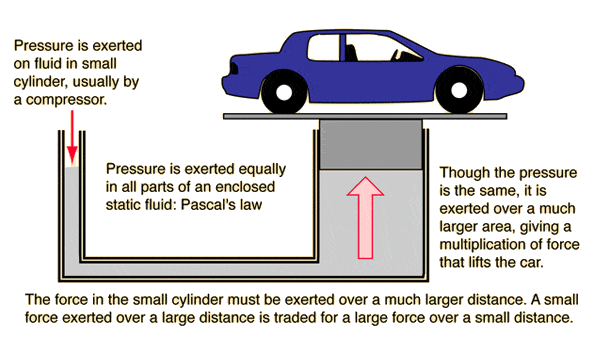
According to Pascal’s Principle, a pressure change at any point in a confined incompressible fluid is transmitted throughout the fluid such that the same change occurs everywhere. Simply stated, if you push a liquid through a small opening with a specific amount of pressure in one end of a pipe, then the other end of the pipe with a large opening must exert a large amount of force to keep the pressure equal in the pipe.
How does it work in real life?
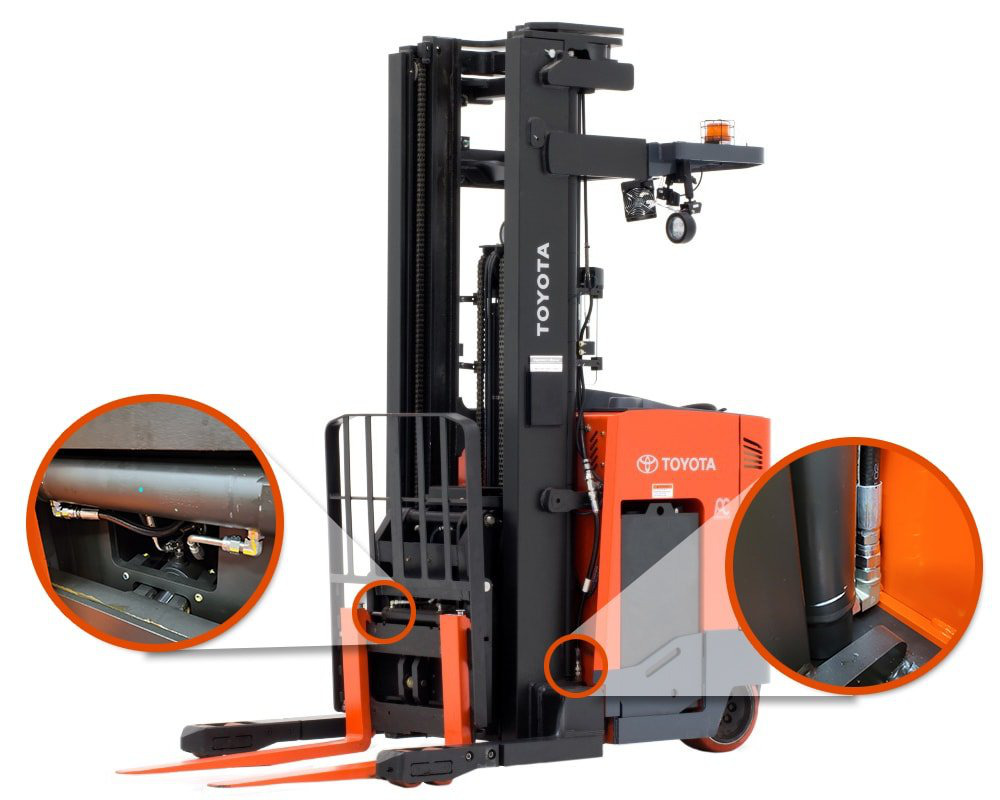
Applying the Pascal Principle to real-life hydraulics is simple. Your forklift has a large tube with a ram in the middle and a small hose attached to either end of the tube. The liquid is pumped into the tube through the hose in the direction you want the ram to move, creating a large pushing force in that direction. On a forklift, you will see many hoses in multiple places where hydraulics are located. The hydraulic system uses the hoses and control valves to pump hydraulic oil throughout the forklift, allowing the mast to move, steering to work, and many other functions.
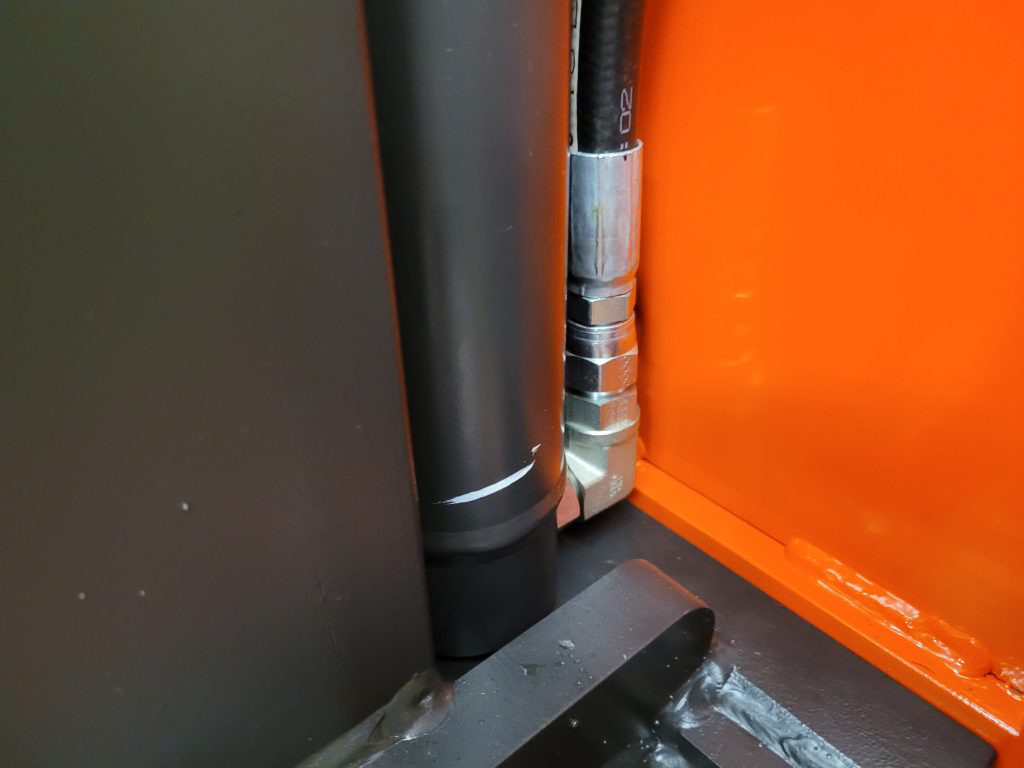
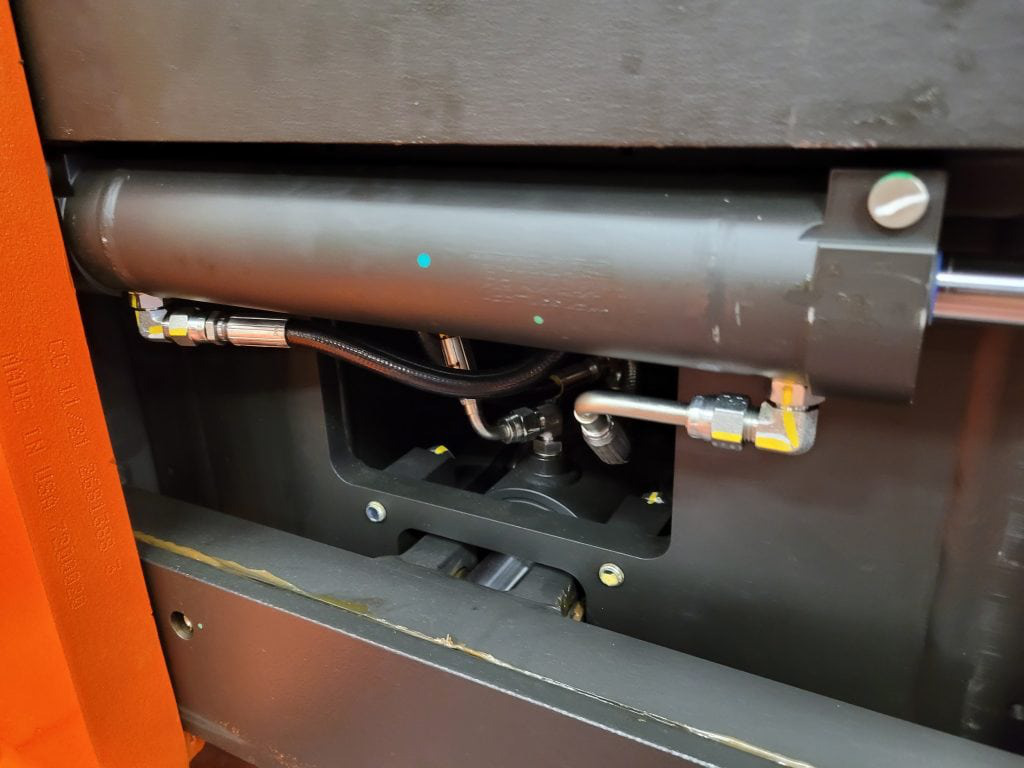
Where are hydraulics used on my forklift?
Hydraulics are essential to a forklift’s function. It is used in many places from steering the forklift, moving the mast, moving the sideshifter, and tilting the carriage, along with many other auxiliary functions. Your Toyota forklift uses a central fluid system which means the same fluid is pumped to the mast, steering, and any other places that need hydraulic fluids. As a result, your forklift uses only one powerful pump to move everything on the forklift, improving the ease of maintenance on your lift.
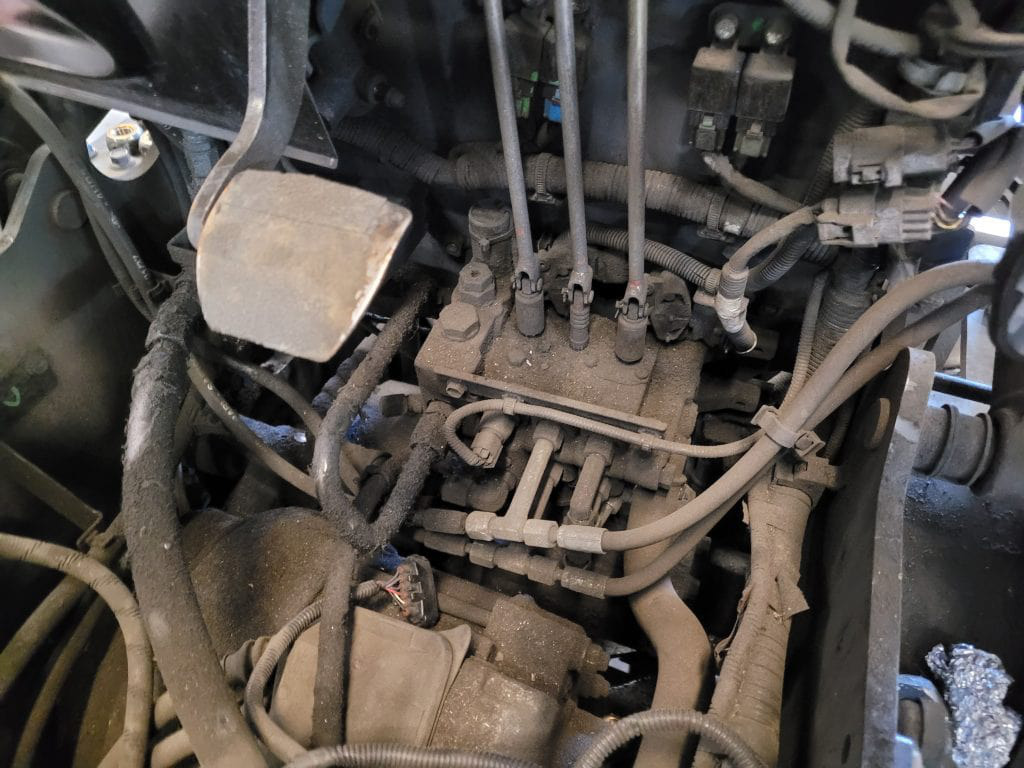
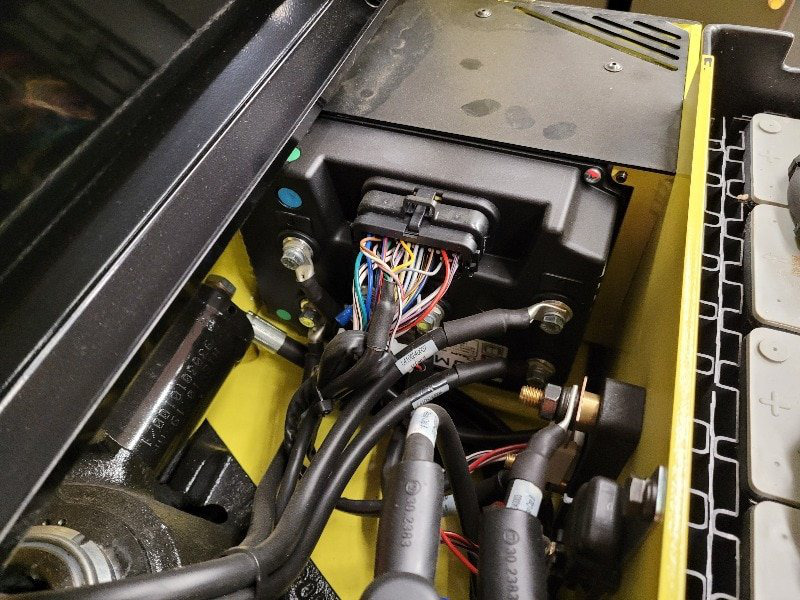
Why Should I Maintain Hydraulics On My Forklift?
Now that you know what hydraulics are and how important they are to the operation of your forklift, you should understand why it is important to maintain this system. Your forklift’s hydraulics move large, heavy loads daily and if the system breaks down, especially when moving a large load, it could be catastrophic. It is not uncommon for considerable damage to occur when a hydraulic system fails in the middle of a job.
Hydraulic system failures can cause floor damage based on falling products as well as safety and financial concerns. For example, leaks from hydraulic lines are dangerous and an extreme safety concern, creating potential slip-and-fall hazards, fire danger, and environmental contamination. Leaks can also cause skin burns and, at times, penetrate the skin.
Any time a piece of equipment breaks down it can be costly. The average hydraulic system repair on a forklift is $1,800, and those repairs can just be the first part of the domino effect for equipment repair. This decreases the overall lifespan of the machine and can potentially slow down production and cost you more in replacement expenses. It’s in your business’s best interest to keep your forklift hydraulic system maintained regularly, with an annual checkup.
Routine Hydraulic Maintenance Checklist
Like an oil change on your car, the hydraulic system on your forklift should be inspected every 1,000 hours. While there are things to look out for on a daily/weekly basis, like oil levels, temperature checks, and leaks, the following are regular tasks done on your 6- and 12-month inspections.
- Change Filters Regularly– Just like changing your oil filter on a car, changing the filter on your forklift will allow the hydraulic system to work at peak efficiency.
- Tube Rod Condition– Make sure to visually check the hydraulic tube rod for wear, corrosion, and pitting (pits on the rod). Rods must be uniformly smooth throughout to work effectively.
- Seal Replacement– The hydraulics tube’s seal is important to its function. If the hydraulic rod is rusted or has pitting, then it can damage the seal on the hydraulic tube. Other damage to the seal can come from excess pressure or fluid contaminants. If any of these problems occur, then you may need to replace the seal on the tube.
- Hydraulic Lines– Regularly check the hydraulic lines for ballooning. This is caused when excessive pressure from the cylinder pushes high pressure fluid past the line which can wear out the seals. If you see your lines ballooning, then it will need to be replaced.
- Inspect Fluid Levels– To get the best out of your forklift, regularly check the hydraulic fluid’s levels. Too little fluid can damage the pumps. Also be careful not to mix oils and that the fluid meet specifications provided by the manufacturer.
- Check Breather Caps, Filler screen and Breather Filters– Make sure to keep the breather caps clean and replace the filter regularly. The breather cap and breather filters keep most contaminants in the air from getting into your hydraulic system.
- Visually Check All Pipes, Pipe Connections and System Hoses– If hoses are pinched, kinked, frayed, bubbling, stretched or otherwise damaged, they can restrict the flow of fluid or they may lead to pressure leaks. Most of these problems are visible from the outside, but you will also have to watch for issues indicating internal wear that could potentially clog a hose.
Check pipes, fittings, and couplers as well. Look for any dents or corrosion on pipes. Fittings should be snug, but not overly tight, and couplers need to stay clean, to prevent contamination.
Aside from excessive oil consumption, leaks can also lead to overheating and severe safety and environmental hazards. These can be difficult to clean up and dangerous for employees, so watch out for signs to prevent leaks in the first place. - Check the System Temperature– If your system temperature gets too hot, it could indicate an issue with your cooler or relief valve. Low fluid levels could also contribute to heat. Use built-in or infrared thermometers to check temperatures. Do not touch components that you suspect may be hot, as this can lead to severe burns.
- Visually Inspect Inside the Reservoir– Aeration within the reservoir can cause overheating and wear on seals and system components. It happens when air bubbles enter the oil stream, from low fluid levels, low fluid temperatures, air leaks, and/or bad seals. Foaming, loud gurgling noises and whirlpools at the suction strainer are indicators of aeration.
- Listen to the Pumps– Listening to the pumps gives you an idea of cavitation that may be present. While similar to aeration, cavitation is the result of gas bubbles experiencing rapid changes in pressure. They implode and cause miniature shock waves. These generate wear and repeated stress on the metal surfaces, damaging the components. Cavitation and aeration have similar causes.
If a pump is cavitating, it will release a high-pitched whining sound. - Inspect a Sample of Hydraulic Fluid– To check your fluid for quality, take a small sample and inspect it. Do a quick visual inspection for color abnormalities and visible contaminants. You may also want to inspect for any unusual odors. Performing a contamination test may offer a more accurate review of the fluid’s qualities, including particle contamination, water contamination, viscosity, acidity, and signs of overheating.
- Perform Hydraulic Valve Maintenance– Scan electrically controlled Servo valves using an infrared thermometer and check the temperature of these valves. If it is higher than 150℉, you may have a problem with the valve. Slow or errant operation at the valve points can be a sign of contaminated fluid.
- Check the Electric Drive Motor– Keep your infrared thermometer out and use it on the electric drive motor to detect any areas of high heat. These areas could be on the housing or rotor bearings and require servicing to avoid further damage to the equipment.
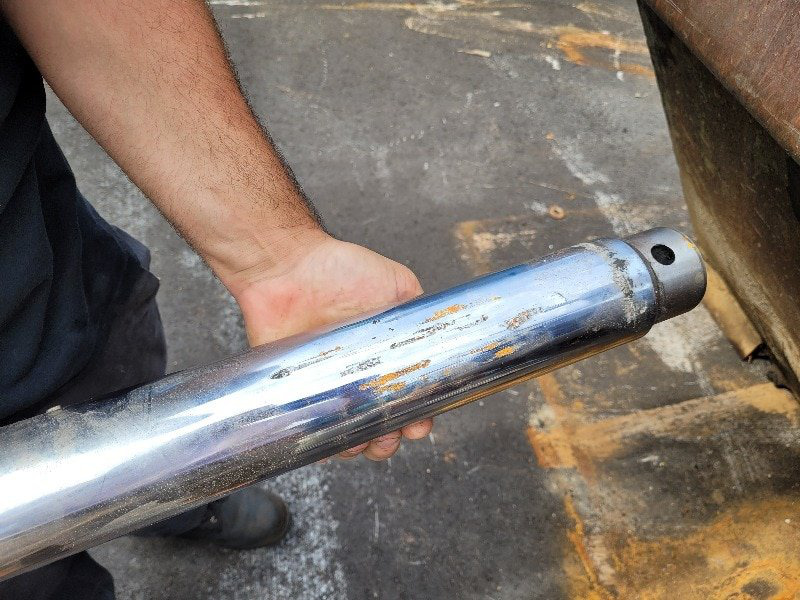
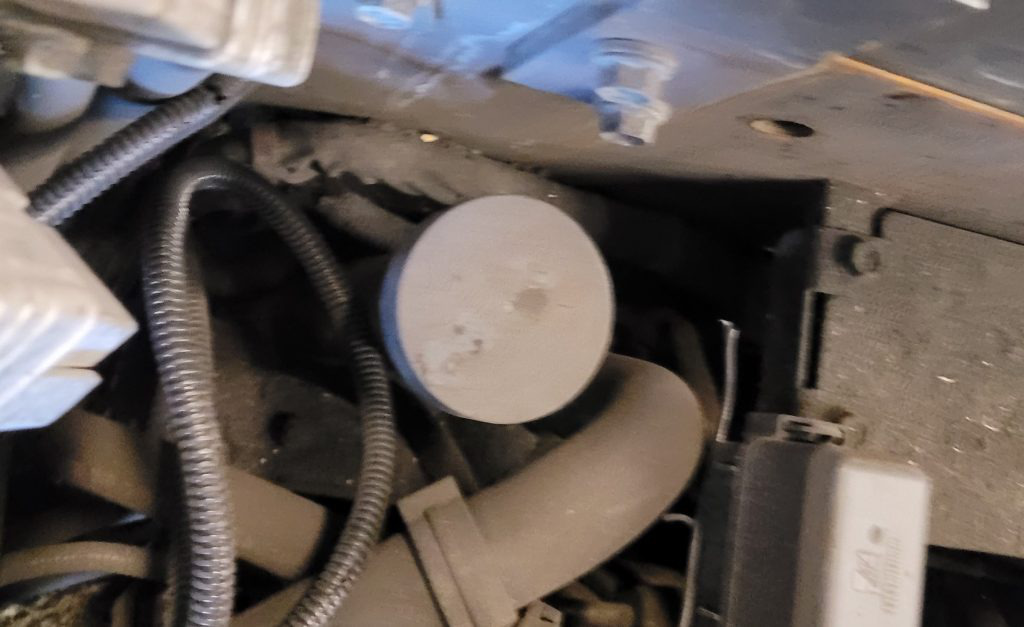 |
Want to know more about hydraulic fluids on your forklift? Check out this Guide to Changing Hydraulic Fluid for Forklifts.
